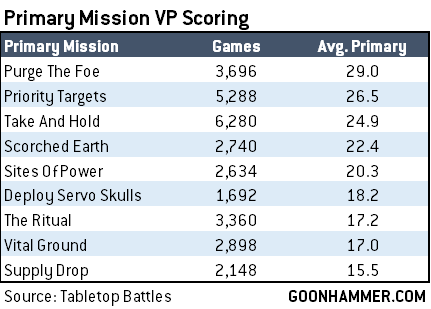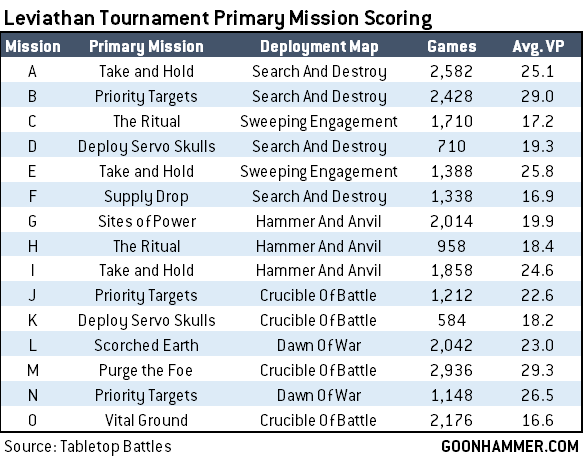Hello Dear Reader, and welcome back to Hammer of Math. Primaris Kevin was indisposed this week so you once again get me, pulling statistics data from our stats site, 40kstats. Last time around I talked about datamining datasheets and promised a part 2 to that article, but today I’m here to take a look at some early scoring data now that we have a full month or so of 10th edition games to work with. As I write this we’ve got 15,368 games worth of Leviathan GT, and where noteworthy I’ll point out the differences between the GT and non-GT games.
So let’s dive right in. Note that the data here comes from games recorded in the Tabletop Battles App, our proprietary app for tracking games of Warhammer. Also it supports Age of Sigmar now, so if you haven’t downloaded it yet, you should absolutely go get it .
Primary Scoring
Currently, players are scoring an average of 22.5 points for primary in Leviathan GT missions. I don’t have winners and losers data yet, but we’ll add that soon. Note that while we aren’t breaking these out by mission rule, we can generally assume at the moment that most of these games follow the basic mission structure laid out by Games Workshop, i.e. using their Missions A-O recommendations, so The Ritual will also be a mission that tends to use the Scrambler Fields Mission Rule.
Anyways, looking at the average we can see that missions range from very generous – Purge the Foe rewards 4 VP at the end of each battle round for killing one enemy unit, and another 4 VP for killing more than the opponent did. Add that to 4 VP for hold one and you’ve got a mission where it’s easy even in a loss to score 8 VP per round.
Following this is Priority Targets, which just gives flat 5 VP for each marker you control up to 10 per turn. And looking at these two missions we can quickly see the pattern: Purge the Foe, Priority Targets, Scorched Earth, Take and Hold, and Sites of Power are the missions which award you full VP for holding an objective marker in your deployment zone. The odd one out here is Vital Ground, which does give VP for holding the marker in your deployment zone, but only 2 VP compared to 5 for those in No Man’s Land. This combines with having one fewer objective marker (in this mission you remove the one closest to the center of the battlefield) to give us the second lowest-scoring mission of the bunch.
At the bottom is Supply Drop, which like Vital Ground removes objective markers, but does so later in the game, and at the same time only awards VP for holding objectives in No Man’s Land. Players on this mission randomly determine an alpha and omega objective in No Man’s Land before the game. The Alpha is removed at the start of round four, and all but the omega is removed from No Man’s Land at the start of round 5. In practice this will often mean players focus less on the alpha and non-Omega objectives, depressing scoring as they fight over the one which awards 15 VP for holding it at the end of the game.
The big surprise here is The Ritual, a mission where players can create new objective markers during the battle. Given the prospect of creating a dozen new objectives during a game it seems like that mission should have higher scoring. However the strict need to do it at 9″ away from another objective and in No Man’s Land may be depressing scoring here. Or maybe players haven’t quite figured out how to play it yet. This will be an interesting one to watch over time.
The Impact of Deployment Map
Deployment Maps don’t seem to impact primary scoring much. The average primary scoring for each map was between 21 and 24 VP, with Hammer and Anvil coming in at 21 VP and Search and Destroy clocking in at 23.7. That’s just enough to be a significant difference, and it makes sense as the missions which allow you to deploy furthest and closest to each other. But Primary Mission has a much bigger impact – at best, the Deployment Map acts like an additional accelerating factor.
Where this will matter most is looking at the Leviathan GT Missions Pool.
First, let me say: Most people do not seem to want to play Deploy Servo Skulls and frankly I agree. We’ll have more data on go-first win rates soon but this is the mission where I think it’s going to show the largest problems, and also a mission where I suspect most players still do not realize that both players can move objectives each turn.
Priority Targets is still the highest-scoring mission of the set, though we can see how putting the mission on Search and Destroy as one of the two primary deployment maps helps bump that up by giving us a scenario where the armies deploy closer and are rewarded for killing units. Mission B also puts an extra objective marker on the table, further bumping that score up by making it easier for the losing player to hold a single objective while making it easier to “tie” on objectives held and prevent a player from holding more.
Vital Ground/Crucible gives us our lowest-scoring mission, which makes sense as it’s the only mission with four objective markers, though Supply Drop is very close.
Gambits
For the final part of this, let’s talk about Gambits. Gambits are a mechanic that was fairly controversial upon announcement but something I haven’t seen much on them since – and that’s probably just because they almost never come up in a game.
When it comes down to it, Gambits just don’t come up very often – only in 1.9% of games played in our Leviathan GT sample, or 287 games in our sample. Of those, players only succeeded 10% of the time, in 28 games. Of the options, Orbital Strike Coordinates was the most popular by far, being the one that’s almost always achievable – Delaying Tactics and Evacuation may not even be possible depending on the army states – though as a result, it was also the least likely to win the game for its players. That’s the other rub – players only won off gambits about 12% of the time, meaning that in our sample of more than 15 thousand games, only 7 were won by a player who succeeded at a Gambit. Just as noteworthy are the 28 or so games where a player chose a Gambit and won despite it not being successful – how much of that was dramatic turnaround vs. a misreading of the board state would be fascinating to know.
Either way, these are some tiny numbers, and they both showcase how rarely Gambits will actually impact a game, and how difficult it will be to evaluate them in that context.
Final Thoughts
That wraps up our look at primary scoring. I’ll be back at some point relatively soon to talk about Secondary Scoring, though before I do that we have some more work to do on new pages for 40kstats. In the meantime, if you have any questions or feedback, drop us a note in the comments below or email us at contact@goonhammer.com.





